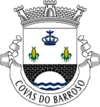Covas do Barroso
| Covas do Barroso | ||
|---|---|---|
| Parish | ||
| ||
 Covas do Barroso | ||
| Coordinates: 41°38′10″N 7°46′59″W / 41.636°N 7.783°WCoordinates: 41°38′10″N 7°46′59″W / 41.636°N 7.783°W | ||
| Country | Portugal | |
| Region | Norte | |
| Subregion | Alto Trás-os-Montes | |
| Intermunic. comm. | Alto Tâmega | |
| District | Vila Real | |
| Municipality | Boticas | |
| Area | ||
| • Total | 29.58 km2 (11.42 sq mi) | |
| Population (2011) | ||
| • Total | 262 | |
| • Density | 8.9/km2 (23/sq mi) | |
| Postal code | 5460 | |
| Area code | 276 | |
| Patron | Santa Maria | |
| Website |
cbarroso | |
Covas do Barroso is a civil parish (Portuguese: freguesia) in northern Portugal, in the municipality of Boticas, in the old district of Vila Real. The population in 2011 was 262,[1] in an area of 29.58 km².[2] Located in the subregion of Alto Trás-os-Montes, it comprises three villages: Covas do Barroso, Romaínho and Muro.
History
During the Middle Ages, Covas do Barroso consisted of five settlements: Couto de Dornelas, São Salvador de Viveiro, Canedo, Cabanelas and São Martinho). But, owing to deaths caused by the plague, the latter two settlements (Cabanelas and São Martinho) were extinguished.[3]
The place's toponymy originated from its geographic location: the place is surrounded by mountain hilltops, and once seen from Alto do Castro, appears as ditch (Portuguese: cova).[3]
The settlement of this territory corresponds with the ancient castros discovered in this area.[3] In many of these castros discoveries of archaeological artefacts have been common, including Byzantine coins, from the era of Emperor Ducas.[3]
Apart from archaeological proofs, the documented references refer to the existence of Covas do Barroso after the 12th century.[3] Covas do Barroso was part of the municipality of Montalegre, until 6 November 1836, when the neighbouring municipality of Boticas was established.[3] During this creation, Covas do Barroso passed into the administration of the latter, while judicially it was integrated into the Comarca of Chaves (in 1839), Montalegre (in 1878), and finally integrated into the Julgado de Eiró (in 1878). The attempted transfer of Covas do Barroso to municipality of Ribeira de Pena created conflict within its citizenry.[3]
It was not until 1839 that its inhabitants received its first primary school (supported by a school headmaster who received a stipend of 20,000 réis annually).[3]
Similarly, full electric light and electricity only arrived in 1966, owing to the installation of a generator in Aguieira.[3]
Geography
Covas do Barroso situated in the river-valleys of the Serra de Dornela, 17 kilometres from the municipal seat of Boticas, it consists of the localities of Covas do Barroso, Romainho and Muro. It is confronted by the parishes of Couto de Dornelas, São Salvador de Viveiro and Canedo. [3]
References
- ↑ Instituto Nacional de Estatística (INE), Census 2011 results according to the 2013 administrative division of Portugal
- ↑ Direção-Geral do Território
- ↑ 3.0 3.1 3.2 3.3 3.4 3.5 3.6 3.7 3.8 3.9 Junta Freguesia, ed. (2010). "Historial" (in Portuguese). Covas do Borroso (Boticas), Portugal: Junta Freguesia das Covas do Borroso. Retrieved 12 April 2011.
